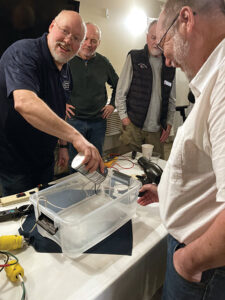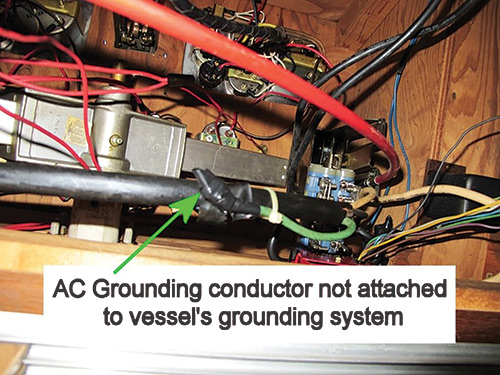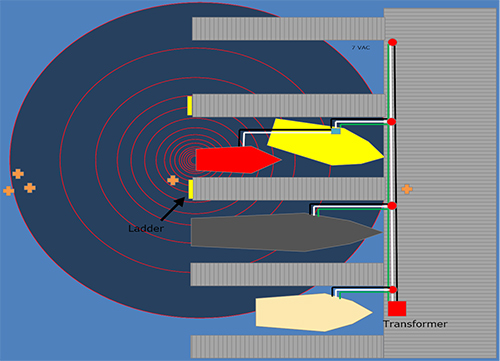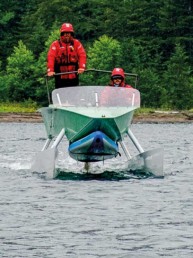
Between the classic movie Jaws and Shark Week, I used to think that sharks were the most dangerous entity in the water. I can recall fear eroding my desire to spend time wading in the water’s edge at the beach or dangling my hand over the side of a small motorboat. But after attending a recent workshop at my yacht club on marine electrical safety, I now fear that the silent killer of the deep is actually electricity.
In a devastating and tragic retelling of his son’s electrocution death over 20 years ago, electrical instructor Kevin Ritz described the invisible danger of leaking currents, poorly maintained systems, and incorrect wiring that can lead to injuries and fatalities.
When my wife Laura and I initially looked at our soon-to-be first boat—Columbia 28 Ariel—almost three years ago, the electrical system was the last thing on our checklist. While I was mostly unfamiliar with boats, I did know that they operated primarily on DC current while at sea, and I was quickly aware of the ubiquitous yellow shore power cord from the dock pedestal to the cockpit that brought in AC for the use of appliances like microwaves, heaters, and other electrical conveniences in the marina.
But I was unaware of through hulls, grounding wires, and the integration of DC and AC currents on a boat. Fortunately, my minor experience with wiring plugs and lights in my house gave me a foundation with which to follow Ritz’s presentation.
Ritz, who is a faculty member for the Northwest School of Wooden Boat Building, was careful to remind everyone present to exercise the utmost caution and knowledge when working with marine systems. Far from learning how to troubleshoot or install a marine electrical system, I nevertheless left the evening seminar with powerful and important knowledge. Here are a few highlights that helped my understanding.
Not all electricity is created equal. There is a tremendous difference between direct current, DC, and alternating current, AC. Ritz jokingly asked if any of the attendees had ever stuck the two leads of a 9-volt DC battery on their tongue. All but two people sheepishly admitted to the foolish practice, myself included (I was about 10 at the time, honest!).
While DC current travels uniformly in one direction from the negative to the positive, alternating current does exactly what its name says: it alternates about 60 times per second between negative and positive. It creates an electric field that is actually measurable through insulated wires. In general, DC does not pack the punch that AC can deliver, hence the non-lethal scenario of the 9-volt battery on the tongue.
While DC current is not as dangerous as AC, Ritz reminded attendees that the two systems are connected through the ground, or bonding, wires on a boat. And as such, incorrect wiring, has serious and possibly deadly consequences were it ever to be the case that AC made its way through a dedicated DC wire.
Electricity flows from the more negative to the more positive. Why don’t birds get electrocuted when perched on a power line? While the wires have an insulating cover to create a shield, or “resistance” to use a more correct term, the real reason is that each tiny foot of the bird is in contact with the same voltage. Only when there is a difference in voltages will a current or flow exist. Given two different voltage potentials, electricity will find all conductive pathways to equalize that difference or return to its initial source of power.

Metaphors for electricity are helpful when trying to understand its complexity, although most are incomplete. Electricity is quantified in two main ways: voltage and current. Voltage is analogous to force, akin to the weight or mass of an object, or even a cistern of water. Imagine a piano or safe being hoisted to the third floor of a building, or a wooden water tower filled with 10,000 gallons of water. More weight or water is equivalent to more voltage, with both scenarios creating a potential for equilibrium. In the massive weight scenario, gravity is acting upon the object to return it to the ground. For electricity, the difference in voltage is the reason behind its movement along a conductive pathway.
Current, keeping with the water tank analogy, can be thought of as the size of a hose delivering the water from a giant elevated tank. A thin, small diameter hose is akin to a small current, or amperage (the strength of current measured in amperes). A large hose allows more flow, and therefore, more current.
Ritz reminded participants of downed power lines from a storm that could be in direct contact with a car. While electricity is technically flowing through the vehicle to the ground, a person in the car is safe as long as they don’t touch the ground and the car at the same time. Doing so would create a pathway from the high voltage wire through the person to the less negatively charged ground. Furthermore, because the electrical resistance of the ground is variable (due to density, composition, moisture etc.) a person fleeing the dangerous scenario of downed power lines should “bunny hop” their way to safety. Even the short distance between a person’s two feet as they walk is enough to experience a voltage gradient that can produce a lethal amount of current flowing through their body.
Electricity wants to return to its source, and will get there anyway that it can. Wiring systems, aka paths for electricity, “force” it to return to its origin. An electric plug has an incoming “hot” wire that can be traced back to its source through that yellow shore power cord. Following that path, you can see that the wire traveled from the supply pedestal on the finger pier after journeying from the transformer on the dock, and originating at the generation site way back at the power station.
The plug also has an outgoing wire that returns the electricity back to the source. When you plug in a hairdryer, for example, electricity flows from the hot wire through one prong of the plug, then through the appliance, either heating it up or supplying a magnetic field for the motor, and then out through the other prong, continuing back to its source at the pedestal, transformer, and generator.
The ground wire is the most important wire in an electric system. Beyond the incoming “hot” and outgoing “neutral” is a third wire in the electrical system, the grounding wire. Providing a safety backup, the wire is ultimately integrated with the bonding system through the negative terminal of the engine or the negative busbar on a boat. In the AC system for a land-based house, the bonding wire is a ground wire that carries stray electricity literally to the ground, often through a copper stake driven a few feet into the ground, where the voltage can safely return to its source without incident.
In a boat however, ground wires are connected to the engine block where electricity finds a low resistance pathway back to its source via the AC safety ground of the shore power extension cord. The ground wire essentially provides another path through which current can flow back to its source, and when necessary, trips an overcurrent protection device. In a properly wired marine system, the additional current from the ground wire will pop a breaker and shut off any dangerous electrical leakage into the water. If installed incorrectly, or not at all, electricity from the hot wire could find its way back to its source by way of through hulls, into the water, sending a deadly current rippling around the boat.

An extension cord with the ground “prong” removed is one of the most dangerous problems of an electrical system, and tragically, one that contributed to the death of Ritz’s son. Without the safeguard of a secondary wire that allows current to flow back to its source and pop a breaker, electricity will continue to flow unimpeded into the water.
Don’t swim in a marina, especially near the dock. Electricity that is “leaking’ from an incorrectly wired boat or a marina supply line will be the most dangerous closest to the source. While water conducts the electricity, it also provides resistance as the distance from the source decreases, developing voltage gradients or zones of different voltage.
Pipes attached to finger piers have the potential to carry stray electricity, as do through hulls and propellers of boats. The closer a swimmer is to those objects, the greater the voltage they might feel. Ritz described the horrifying feeling of being in water with an electric current flowing through it. Our muscles seize up, creating the sensation of trying to swim in wet cement. As the current increases, our heart no longer functions.
An electrical voltage differential of about 2 volts per foot can be lethal. As a simplified clarification, if a 120 volt hot wire were to be placed in a body of water, the voltage charge would be greatest at the location of the wire’s entry point. Moving a few feet away in any direction, the voltage would drop due to the water’s resistance, let’s say to about 110 volts. (There is some variation in this amount, due to water salinity, temperature, and other factors.) It is that voltage differential that is lethal. Remember, electricity flows from a higher voltage to a lower one. To simplify the example, imagine If a person’s right arm were located in the 120 volt zone, and their left in the 110 volt zone. The variation in voltage would be more than enough to stop their heart.
Ritz concluded his talk with a demonstration to clarify the point. In a “never try this at home” experiment, he modified the cord of a standard hair dryer by cutting the neutral wire, separating it from the hot wire, and stripping both ends. He then plugged in the cord, and placed both ends of the neutral wire (technically, the neutral emanating from the hair dryer is carrying current) into a plastic tub of tap water, and turned on the hair dryer. While the water in the tub was electrified, high resistance in fresh water created an extreme voltage gradient, resulting in a drop in voltage between the ends of the two wires and a non-functioning appliance. He then poured in salt from a grocery store container. As he poured more and more, decreasing the resistance and therefore increasing the conductivity, the power to the hair dryer increased, evidenced by the louder noise of the blower and the rising temperature of the heat coming from the nozzle.

As the small crowd expressed their amazement at the conductivity of the water, Ritz informed us that the human body has more salinity than the final percent solution in the tub (even more than sea water), allowing it to essentially act as a copper wire between any voltage differential. Another gasp from the crowd filled the room.
I left the presentation far more respectful, if not fearful, of the ever present potential danger of electrical systems. My approach to any wiring project on Ariel will now include a thorough examination of my ability to successfully troubleshoot or monitor the system. I am far less likely to jump feet first into an electrical upgrade, adhering to the philosophy of when in doubt, play it safe, and even in the boating world, always stay grounded.
David Casey is a retired math teacher and semi-professional woodworker and bass player. He plans on using his retirement to build a small sailboat and a kayak, and to explore the waters of southern Puget Sound.
From the author: “Many thanks to Kevin Ritz for his contribution to this article. His knowledge, instructional skills and commitment to safety cannot be understated.” If you are interested in learning more about marine electrical safety, check out his course at Northwest School of Wooden Boat Building: https://nwswb.edu/systemsintensives/






